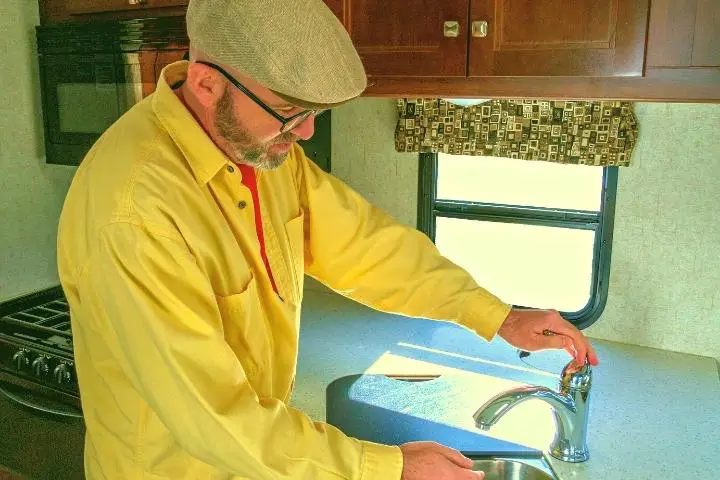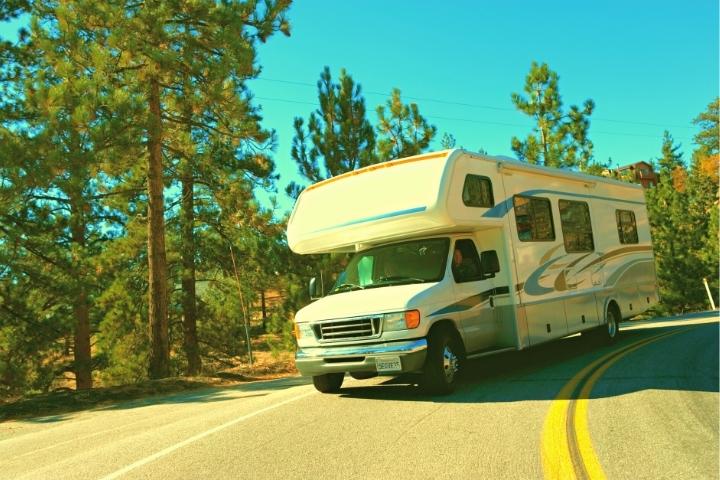What is Grey Water in an RV? (Everything Explained!)
Unlike common, stationary homes – RVs have a unique drainage system that allows people to use water while on the go just as they would back in a brick house. Most of this usage results in the release of what is widely known as “grey water”.
And normally you’d ask, “What is grey water in an RV?”
Well, grey water refers to all the wastewater that runs down the drains in the kitchen, bathroom, and laundry space. It’s always kept in a separate tank away from the one which stores waste from places like the toilet.
But wait…!
There is more to this tale and I’ve laid it all in black and white for you below.
RV Grey Water Vs Black Water
Before I delve too deep, you ought to know that an RV plumbing system comprises 2 wastewater tanks.
They include:
- Grey water tank
- Black water tank
There’s also a third separate tank that works only to carry the RV’s fresh water supply.
So…
What’s the difference between grey water and black water?

The main difference between black and grey water in an RV is often in their individual composition.
As earlier hinted, grey water is all the water coming from your RV’s shower and kitchen. On the other hand, black water is all wastewater collected solely from the toilet.
Given that…
Grey water mostly consists of soaps, grease, and hair that normally washes out of the kitchen/shower. Black water, in many parts, contains fecal and urine matter and should NEVER be mixed with grey water.
It’s more difficult to recycle black water than grey water because of the nature of its contents.
Modern RV models have simple yet efficient systems that can recycle grey water and channel it back for use when flushing the toilet.
The reason why a big spotlight falls on grey water is that it plays a vital role in making sure that the black water tank functions optimally. It does this by providing a steady supply of water that allows organic bacteria to digest some of the solid waste that prevents buildup.
Once a black water tank fills up, you must make plans to dump it as soon as possible to support the normal functioning of your RV’s drainage system.
When Should I Dump My Grey Water Tank?
There is no one-size-fits-all answer to this question since different RVs have different tank sizes. Also, people use their drain facilities variably in different frequencies, depending on the number of campers living in the mobile home at any one given moment.
All in all…
You should wait at least until the grey tank is full or almost full before dumping it. This means that you will have to constantly keep a keen eye on the wastewater levels in the grey tank to avoid being caught off-guard.

To go about it:
- First dump the black tank. Doing this makes it easier to clean the sewer hose as the grey water will flush clean through the pipes when dumped afterward.
- Dump the grey tank. Open your drain valves to allow the waste from the grey tank to flush out through the main outlet.
- Flush both tanks after dumping. Some RV models come with an in-built tank flush that cleans up the tanks after dumping. If you do not have one at your disposal, simply use your preferred cleaning supplies and solutions to do a manual flush.
- Remember to close the drain valves after dumping. This is very important as it helps prevent solid waste from building up in the black tank. This buildup normally happens when water keeps on leaving the tank through the open valve. This can cause blockages that may make your RV smell like sewage.
Note: Always make sure that you dump your grey and black tanks in a reserved dump station. Doing so anywhere else is risky and illegal as it can spread harmful bacteria that can cause diseases.
How to Maintain Grey Water Tanks in RVs
Keeping your grey water tank spick and span is a breeze compared to when you’re handling black water tanks. This is because grey water tanks normally don’t contain a lot of solid wastes run off into them.
Nonetheless, you should still maintain a clean and functioning grey water tank by observing the following few tips:
- Avoid emptying your grey water tank too frequently. Doing so may cause solids to build up along the walls of the tank. Wait until the tank is full before emptying it so that you also get to flush any solid residue that may be stuck inside the drain pipes.
- Pour a bit of washing liquid down your drain before cleaning the grey tank. Doing this helps to break down and loosen any grease or fat stuck in the tank. Cleaning afterward becomes so much easier!
- Avoid using antifreeze products in your RV’s drainage system. Using antifreeze products (even in cold weather) compromises the integrity of the seals used in the plumbing. This can lead to wastewater leaking all over your camper and cause major contamination. If you really must, then consider using external tank warmers for RVs instead.
- Don’t use harsh detergents/solutions when cleaning. Harsh cleaning agents have string chemicals that stop some good bacteria from digesting solid waste from the kitchen or toilet. This causes tons of sludge build-up in your tank which can eventually result in clogs.
Frequently Asked Questions

1. Why won’t my RV grey water tank drain?
The main reason why most RV grey water tanks refuse to drain is due to a clog. Yes…!
Once you notice this problem, it’s mainly because there is a bad clog or blockage in one of the pipes caused by food, hair, or other types of buildup.
Most people tend to overlook this and go in search of other ‘serious’ issues affecting the drainage. But, when you notice that your tank won’t drain, your first course of action should be to check whether you have any type of blockage in your drainage before resorting to other measures.
2. How do I know when my grey water tank fills up?
The best way to find out is by closely monitoring the wastewater level in the tank.
To make things better, there are modern sensors made to read the capacity of grey water tanks without needing you to lift the cap to peep in.
However, you should always be skeptical about these readings as they can easily be affected by solid wastes in the tanks like tissue paper and balled-up hair.
To be on the safer side, I recommend that you always take in the reading as a lot higher than what the sensor device is giving you.





